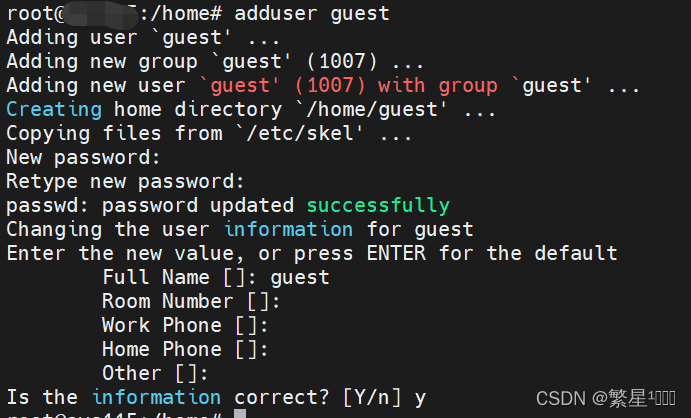【linux】linux新建用户并分组,分配权限
1. 涉及到的命令useradd 选项 用户名usermod 选项 用户名userdel 选项 用户名passwd 选项 用户名groupadd 选项 用户组groupmod 选项 用户组groupdel 选项 用户组2.用户账号管理2.1 新建用户账号useradd help文档Usage: useradd [options] LOGINuseradd -Duseradd -D [options
1. 涉及到的命令
adduser 用户名
useradd 选项 用户名
usermod 选项 用户名
userdel 选项 用户名
passwd 选项 用户名
groupadd 选项 用户组
groupmod 选项 用户组
groupdel 选项 用户组
2.用户账号管理
2.1 新建用户账号
注意新建用户最好用adduser,使用useradd,普通用户不会自动创建home目录,用户首次登录时,虽然能登录,但是还会报错:
Could not chdir to home directory /home/xxx: No such file or directory
/usr/bin/xauth: error in locking authority file /home/xxx/.Xauthority
而且很多命令不能用,如ll
推荐操作总结
addgroup groupname1 #作为主组
addgroup groupname2 #作为从组
adduser username #默认操作,主组是username,shell是/bin/bash
usermod -s /bin/bash -g groupname1 -G groupname2 username
2.1.1 adduser
adduser help文档
adduser [--home DIR] [--shell SHELL] [--no-create-home] [--uid ID]
[--firstuid ID] [--lastuid ID] [--gecos GECOS] [--ingroup GROUP | --gid ID]
[--disabled-password] [--disabled-login] [--add_extra_groups]
[--encrypt-home] USER
Add a normal user
adduser --system [--home DIR] [--shell SHELL] [--no-create-home] [--uid ID]
[--gecos GECOS] [--group | --ingroup GROUP | --gid ID] [--disabled-password]
[--disabled-login] [--add_extra_groups] USER
Add a system user
adduser --group [--gid ID] GROUP
addgroup [--gid ID] GROUP
Add a user group
addgroup --system [--gid ID] GROUP
Add a system group
adduser USER GROUP
Add an existing user to an existing group
general options:
--quiet | -q don't give process information to stdout
--force-badname allow usernames which do not match the
NAME_REGEX[_SYSTEM] configuration variable
--extrausers uses extra users as the database
--help | -h usage message
--version | -v version number and copyright
--conf | -c FILE use FILE as configuration file
创建用户
adduser username1
结果如下图,需要输入密码,并再次输入确认,之后的啥Full Name,Room Number啥的可以不填直接enter,enter就是默认值,最好输入y确认就好了

添加已存在用户到已存在组
注意:这里是groupname是username1的从组
adduser username1 groupname
2.1.2 useradd
useradd help文档
Usage: useradd [options] LOGIN
useradd -D
useradd -D [options]
Options:
--badnames do not check for bad names
-b, --base-dir BASE_DIR base directory for the home directory of the
new account
--btrfs-subvolume-home use BTRFS subvolume for home directory
-c, --comment COMMENT GECOS field of the new account
-d, --home-dir HOME_DIR home directory of the new account
-D, --defaults print or change default useradd configuration
-e, --expiredate EXPIRE_DATE expiration date of the new account
-f, --inactive INACTIVE password inactivity period of the new account
-g, --gid GROUP name or ID of the primary group of the new
account
-G, --groups GROUPS list of supplementary groups of the new
account
-h, --help display this help message and exit
-k, --skel SKEL_DIR use this alternative skeleton directory
-K, --key KEY=VALUE override /etc/login.defs defaults
-l, --no-log-init do not add the user to the lastlog and
faillog databases
-m, --create-home create the user's home directory
-M, --no-create-home do not create the user's home directory
-N, --no-user-group do not create a group with the same name as
the user
-o, --non-unique allow to create users with duplicate
(non-unique) UID
-p, --password PASSWORD encrypted password of the new account
-r, --system create a system account
-R, --root CHROOT_DIR directory to chroot into
-P, --prefix PREFIX_DIR prefix directory where are located the /etc/* files
-s, --shell SHELL login shell of the new account
-u, --uid UID user ID of the new account
-U, --user-group create a group with the same name as the user
-Z, --selinux-user SEUSER use a specific SEUSER for the SELinux user mapping
--extrausers Use the extra users database
最简单,按默认操作创建新用户
useradd username1
设置新用户home目录,默认目录就是/home/username
useradd -d /home/username1 username1
设置新用户登录的shell,shell意思是贝壳,就是说Linux系统内核的壳,用户默认的shell就是/bin/sh,bash是sh的增强版本,sh是bash的缩减版,具体区别参考:sh和bash
useradd -s /bin/bash username1
设置新用户分组,前提是username1之前没创建过。默认分组是用户名自身
useradd -g groupname1 -G groupname2,groupname3 username1
2.2 查看用户、用户组信息
2.2.1 查看当前用户所属组
第一个是当前所在组,其他的是属于的可选的组
groups
2.2.1 查看所有的组
cat /etc/group
2.2.1 查看所有的用户
cat /etc/passwd
/etc/passwd 是一个文本文件,其中包含了登录 Linux 系统所必需的每个用户的信息。它保存用户的有用信息,
包含7个字段:用户名、密码、用户 ID、群组 ID、用户 ID 信息、用户的家目录和 Shell 。
用户名 (magesh): 已创建用户的用户名,字符长度 1 个到 12 个字符。
密码(x):代表加密密码保存在 `/etc/shadow 文件中。
用户 ID(506):代表用户的 ID 号,每个用户都要有一个唯一的 ID 。UID 号为 0 的是为 root 用户保留的,UID 号 1 到 99 是为系统用户保留的,UID 号 100-999 是为系统账户和群组保留的。
群组 ID (507):代表群组的 ID 号,每个群组都要有一个唯一的 GID ,保存在 /etc/group文件中。
用户信息(2g Admin - Magesh M):代表描述字段,可以用来描述用户的信息(LCTT 译注:此处原文疑有误)。
家目录(/home/mageshm):代表用户的家目录。
Shell(/bin/bash):代表用户使用的 shell 类型。
2.3 修改用户账号
usermod help文档
Usage: usermod [options] LOGIN
Options:
-b, --badnames allow bad names
-c, --comment COMMENT new value of the GECOS field
-d, --home HOME_DIR new home directory for the user account
-e, --expiredate EXPIRE_DATE set account expiration date to EXPIRE_DATE
-f, --inactive INACTIVE set password inactive after expiration
to INACTIVE
-g, --gid GROUP force use GROUP as new primary group
-G, --groups GROUPS new list of supplementary GROUPS
-a, --append append the user to the supplemental GROUPS
mentioned by the -G option without removing
the user from other groups
-h, --help display this help message and exit
-l, --login NEW_LOGIN new value of the login name
-L, --lock lock the user account
-m, --move-home move contents of the home directory to the
new location (use only with -d)
-o, --non-unique allow using duplicate (non-unique) UID
-p, --password PASSWORD use encrypted password for the new password
-R, --root CHROOT_DIR directory to chroot into
-P, --prefix PREFIX_DIR prefix directory where are located the /etc/* files
-s, --shell SHELL new login shell for the user account
-u, --uid UID new UID for the user account
-U, --unlock unlock the user account
-v, --add-subuids FIRST-LAST add range of subordinate uids
-V, --del-subuids FIRST-LAST remove range of subordinate uids
-w, --add-subgids FIRST-LAST add range of subordinate gids
-W, --del-subgids FIRST-LAST remove range of subordinate gids
-Z, --selinux-user SEUSER new SELinux user mapping for the user account
2.3.1 修改用户分组
usermod -g groupname1 -G groupname2,groupname3 username1
2.3.2 修改用户名字账号名字
usermod -l newusrname username1
2.3.3 修改用户密码
修改自己账号密码
passwd
修改别人账号密码,需要sudo或者root
sudo passwd username
2.3.4 修改用户home目录
usermod -d /newhomepath username1
2.4 用户组
2.4.1 创建用户组
addgroup groupname
或者
adduser --group groupname
或者
groupadd groupname1
2.4.2 删除用户组
groupdel groupname1
2.4.3 用户组切换
如果一个用户同时属于多个用户组,那么用户可以在用户组之间切换,以便具有其他用户组的权限。
用户可以在登录后,使用命令newgrp切换到其他用户组,这个命令的参数就是目的用户组。例如:
newgrp groupname2
这条命令将当前用户切换到groupname2用户组,前提条件是groupname2用户组确实是该用户的主组或附加组
参考链接:
更多推荐
 已为社区贡献3条内容
已为社区贡献3条内容









所有评论(0)